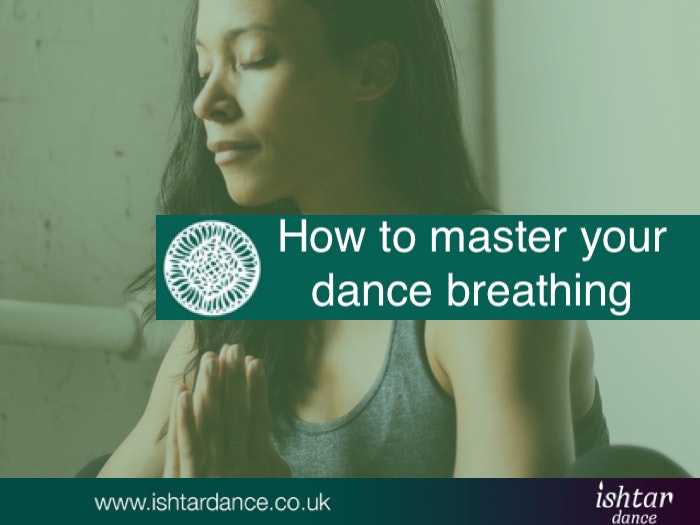How to master your dance breathing
By Ishtar Dance on Monday, March, 11th, 2019 in Dance Coaching, Dance Inspiration, Learning, Your Dance Body 1 Comment

It’s pretty obvious why we have to breath whilst dancing, but surprisingly little emphasis is often being put on how to do this correctly and efficiently. Mastering this however will not only make your body function better, increase your stamina and therefore improve your overall performance, but it can also help you add extra power and drama into your performance.
The average person takes around 22,000 breaths a day, but the waste majority of those will be done automatically and without any thought as to the effectiveness or quality of the individual breath. But any athlete using their body intensionally to performance their best must consider not only how they fuel their body with their breathing, but also on which techniques are used to achieve this.
The basics
Awareness of your breathing is the first step to improving it. Sounds simple, but it’s human nature for us to hold our breath when concentrating or learning new things, so in every single class I remind my students to breath. I also tend to start each class with a couple of deep breaths, so help focus the mind and get awareness into the body. And at the end, using the breath again to relax and prepare for the cool down.
On a basic level your breath fuels your muscles allowing them to work their best and helps you concentrate. But there are different ways of getting the oxygen that your body needs into your lunges and the waste products out again…
Breathing techniques
There are different ways of breathing and we can tap in and out of these to help improve our performance when dancing. Initially your body will pick the one that it needs in that moment, but becoming more aware of your own breathing means that you can also switch between them as a matter of choice.
Applicable breathing
This type of breathing refers to when we’re mainly using the upper part of our lungs. This is how you’ll breath when going for a big run or otherwise exerting yourself physically. It’s great for when the body really needs to increase the amount of oxygen it gets, due to increased heart rate. But many people also breath like this when stressed, due to the fight or flight instinct.
You may end up breathing like this after doing a big solo or having done lots of jumps, but it’s not the ideal breathing technique for dancers, as it can utilise some of your neck muscles to lift and allow the chest to expand. Not to mention how impossible it would be for you to conduct upper body isolations whilst also breathing like this. So make sure you don’t use this as your standard breathing technique.
This type of breathing is mostly done with your mouth open.
Lateral breathing
Also called basal breathing, this is the most efficient way of breathing most of the time when dancing. This is when you allow your lower ribs to expand and take in lots of air to fuel your body, but without it looking like your running a marathon and gasping for air (even if you may feel like you are!). If you’ve ever been told to breath through your ribs/ribcage, this is probably what they meant.
This types of breathing will allow your to relax your abdominal muscles, but also to switch your lower abs on with ease. This type of breathing can be controlled by breathing through the nose, but also through the mouth.
Abdominal breathing
Also sometimes called belly breathing, but this is not how a belly dancer should ideally breath… This type of breathing is great for singers because it allows the abs to release, and therefore the diaphragm to drop, increasing the air intake. It’s also a breathing technique sometimes used in yoga, although lateral breathing often is needed to perform moves where the abs are engaged.
Working with your breath
If you want to start controlling your breathing consciously then start by breathing in and out through your nose and feel how your lower ribs expand. Lateral means side, so to feel and practise your ‘side breathing’ by placing your palms on the side of your ribs and feel how the lungs flair out on the inhale and back in on the exhale. Try it lying down with one hand on the top of your belly/lower ribs and one hand on the side; you should feel the distance between your rips grow and hand on the side being pushed away slightly.
Please don’t start hyper ventilating! Breathing deeply should be done slowly and relaxed. Breathing in on a count of three and out on a count of 4/5 is great for practising the control of your breath. Extending your exhale period can also be a great relaxation technique in its own right, for example inhaling on 3/4 and out on 8.
If you’re just starting to get to grips with your controlled side-breathing, then make sure to ask your teacher or dance coach to keep and eye on you in class. If you’ve already got the basics, then try mixing the different techniques up to see how they feel. That way you will hopefully be able to stop yourself when you start breathing at the top of your chest halfway through class. You may also discover that it doesn’t work to apply abdominal breathing whilst doing certain moves – mainly because you lose control of your core and basic posture.
Bottomline is, try to maintain lateral breathing even when you start increasing your heart rate. Your chest may start rising too, but if you didn’t breath deeply into your lungs at the same time, your chest would rise and fall even more, making it difficult to achieve control of posture and isolations.
Using your breath during performance
There are many ways you can add oomph and drama to your performance by using your breath.
As a general rule – never hold your breath – because as you’ve already learned it will mean your body can’t perform at it’s best. But also, when you do, so does your audience! So maybe you do want to hold it – just a second or two, whilst you role your shoulder, circle your chest or similar… But don’t forget to only use it sparingly and intensionally to add drama and suspense.
Flutters of the diaphragm (belly flutter) are another reason why you may want to hold your breath, but make sure you practise this carefully. There are so many elements to this, that it will be the topic of a future post.
Finally, you can use your breath to support your moves, which I will cover much more in my upcoming workshop all about ‘Breathing life into you Dance’. This will be available online too, so if you’d like to find out more, do make sure you’re signed up to my newsletter here to be the first to know all the details.
I hope you enjoy working consciously with your breath to improve your performance and dancing. Let me know how you’re getting on, how you’re using breathing in your dancing and not least how your helping your students becoming aware off and using their breathing in the best possible way.
Happy and beautiful dancing 🙂
Dorte
Did you miss my last post? Read it here: Staying inspired…

Thank you for this post. I’ve read couple of texts for breathing while dancing and this one i felt the most, more precisely lateral way of breathing. I am learning to breathe for latin dancing.
Wish you all the best!